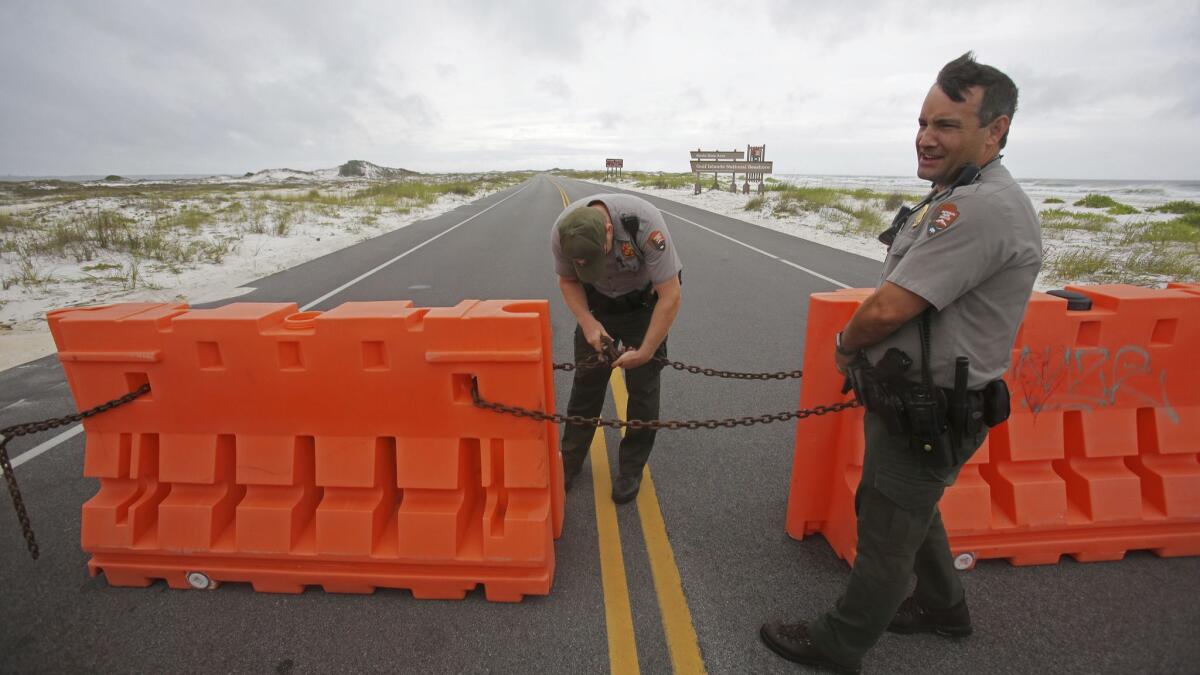Alberto downgraded to a depression, but rain is still heavy across the Southeast

- Share via
Forecasters downgraded Alberto to a still-dangerous depression Monday evening, warning heavy rains and an accompanying flood threat would continue in the aftermath of the storm’s landfall in the Florida Panhandle.
The Memorial Day strike on the Gulf Coast by the first named storm of the 2018 Atlantic hurricane season drove holiday beachgoers away from roiling, dangerous surf. What had sprung up from the Gulf of Mexico as a subtropical storm was now a vast, soggy system trekking inland as it flung rain — heavy at times — all around the Southeast.
Forecasters warned that heavy downpours from the weakening system could raise the potential for life-threatening flash floods in coming hours or days across north Florida, much of Alabama and large areas of Georgia — and eventually into Tennessee and the Carolinas.
The National Hurricane Center in Miami said the depression was centered at 11 p.m. EDT Monday about 50 miles west-northwest of Dothan, Ala. Its top sustained winds had dropped nearly in half to about 35 mph. What remains of Alberto was crawling northward at about 12 mph.
Authorities did not immediately attribute any deaths or injuries directly to Alberto. But in North Carolina, a television news anchor and a photojournalist were killed Monday when a tree that had been uprooted from rain-soaked ground toppled on their SUV as they reported on severe weather on the fringes of the huge system.
That was hundreds of miles from Alberto’s center.
Between 4 and 8 inches of rain could soak the Florida Panhandle, Alabama and western Georgia before the storm moves on. Isolated deluges of 12 inches also are possible in spots as the system heads toward the Tennessee Valley on Tuesday and later this week into the Ohio Valley and Great Lakes region.
Earlier Monday, Alberto rolled up big waves and tides along beaches of the northern Gulf Coast. Lifeguards posted red flags along the white sands of Pensacola Beach, Fla., where swimming and wading were banned as Alberto disrupted holiday weekend plans for millions.
The storm also forced some Memorial Day tributes to be canceled across Florida’s Panhandle. Safety was the priority, but the decision was still a “heartbreaker,” said Tom Rice, a 29-year-old Army veteran who had helped with planning for a ceremony at Beal Memorial Cemetery in Fort Walton Beach.
Some stragglers still made their way through the rain to pay tribute at the cemetery’s Veterans Tribute Tower. Rice said American flags had been placed Saturday on the graves of all 1,700 veterans buried in the cemetery.
“We got the flags out,” Rice told the Northwest Florida Daily News as wind whipped a massive U.S. flag flying at half-staff. “That’s what’s important.”
Along the Florida Panhandle, tourists vowed Alberto wouldn’t dampen their fun.
Jason Powell sought to keep his children entertained with movies and TV, adding he hoped the sun would come out again after Alberto blew over. “So far we’ve seen a lot of wind and the ocean is really high, covering up the entire beach,” Powell said.
Janet Rhumes said her group of friends from Kansas had been planning their Memorial Day weekend on Navarre Beach since October. They stocked up on groceries and settled in for card games. “We’ve never seen one before and we’re here celebrating a friend’s 20th birthday,” Rhumes told the Daily News. “So how often can you say you rode a storm out?”
As Alberto’s weakening center heads inland it is being deprived of the warm waters that fuel tropical weather systems. As a subtropical storm, Alberto had a less defined and cooler center than a tropical storm, and its strongest winds were found farther from its center. Some of the rain bands spread hundreds of miles away from the center.
Elsewhere, the North Carolina Highway Patrol said, a large tree toppled on a news television vehicle Monday near Tryon, N.C.
WYFF-TV of Greenville, S.C., said a news anchor, Mike McCormick, and photojournalist, Aaron Smeltzer, with that station were both killed.
McCormick and Smeltzer had just interviewed Tryon Fire Chief Geoffrey Tennant as they covered storms in North Carolina.
“Ten minutes later we get the call and it was them,” Tennant said at a news conference, his voice cracking.
Tennant did not directly blame the up to 2 inches of rain that fell Monday from the fringes of Alberto for the deaths. He said the roots of a large tree that toppled on the vehicle came loose from ground saturated by a week’s worth of rain.
The men died instantly, their TV vehicle’s engine still running, Tennant said.
UPDATES:
8:35 p.m.: The story was updated with the storm being downgraded.
The story was originally published at 2:25 p.m.
More to Read
Sign up for Essential California
The most important California stories and recommendations in your inbox every morning.
You may occasionally receive promotional content from the Los Angeles Times.











